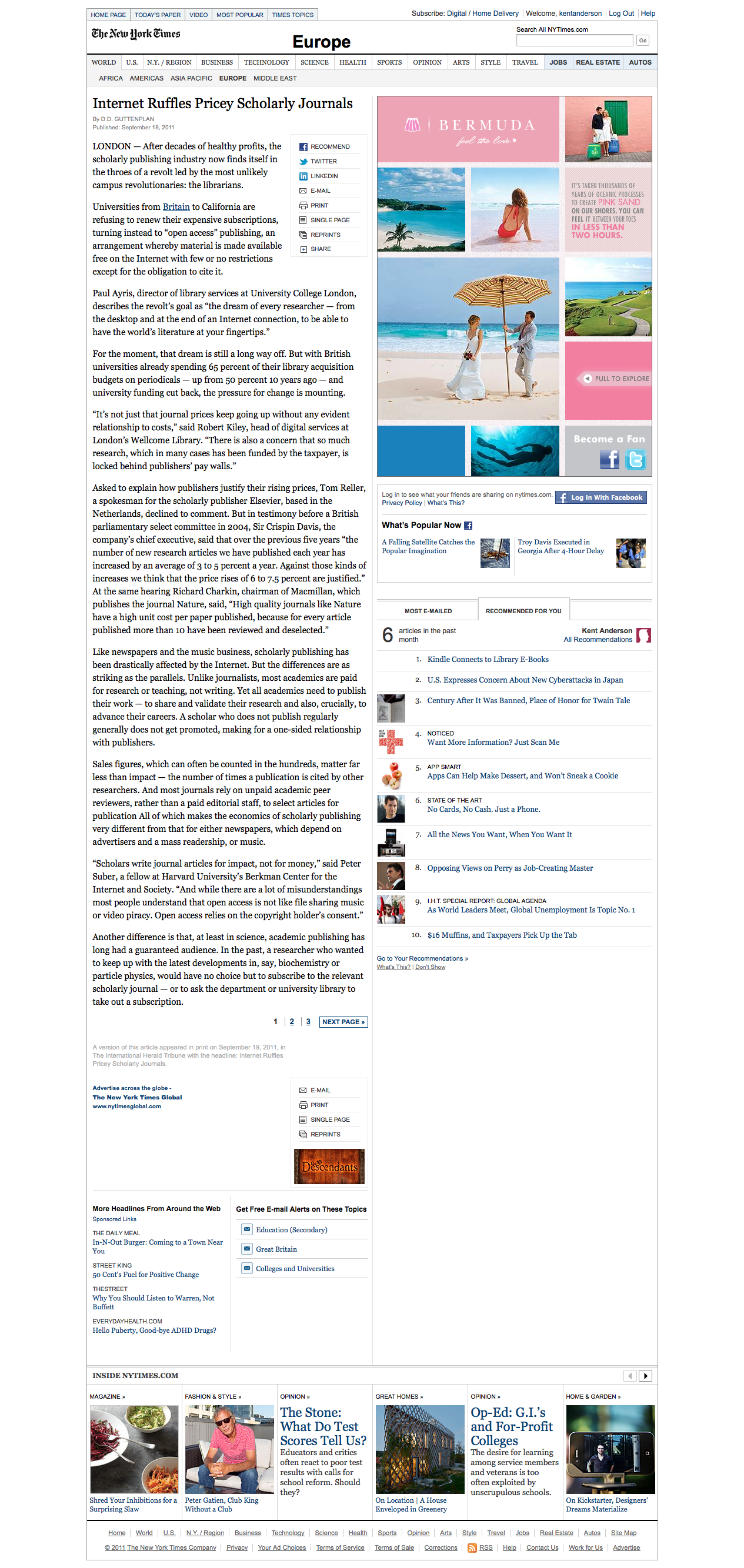Last week, I continued what is turning into a saga, covering another open access pitch piece emanating from London, this one appearing in the New York Times.
Or did it appear in the New York Times?
The question has important implications for branding, trust, and integrity.
Bill Kasdorf helped uncover this question by emailing and tweeting the following:
Everybody should forward
@kanderson‘s OA post on@scholarlykitchn to Arthur Brisbane@thepubliceditor of the@nytimes, public@nytimes.com
Bill also followed up with an email to Arthur S. Brisbane, the Public Editor and Reader Representative of the New York Times, which read:
Dear Mr. Brisbane—
Kent Anderson, editor of the Society for Scholarly Publishing’s popular publishing blog The Scholarly Kitchen, has posted a very important critique of D.D. Guttenplan’s recent article on Open Access. Kent’s post is thoughtful, well informed, and a valuable corrective to a piece in the NYT that was, however unintentionally, seriously incomplete and one-sided, perpetuating a distorted view of an issue of critical importance to publishing today.
I urge you to read Kent’s post. It’s at https://scholarlykitchen.sspnet.org/2011/09/22/london-calling-open-access-pr-wends-its-way-from-london-into-a-major-us-newspaper/.
A few hours later, Bill received the following response:
Thanks for writing. Since this article appeared in the International Herald Tribune, and not The New York Times, we won’t pass judgment on the article in question, but we will make sure the appropriate person sees your email and the link to Mr. Anderson’s blog post.
We appreciate the feedback.
Best,
Joseph Burgess
Office of the Public Editor
The New York Times
public@nytimes.comNote: The public editor’s opinions are his own and do not represent those of The New York Times.
(I’m still trying to figure out why an editor at the New York Times needs fine print like the line above.)
Bill shared this email with me, and I quickly checked my link to be sure I hadn’t made some stupid error. Nope, sure enough, the page is a New York Times page, the URL is an nytimes.com URL, the editorial integrations are with other New York Times stories, the search is for NYTimes.com, my identity is validated by the New York Times’ database, the subscription options are for the New York Times, the “Today’s Paper” is for today’s New York Times, etc. It sure looks, walks, and quacks like the New York Times:
 Bill was nice enough to send another email to the Public Editor at the New York Times, one which included the graphic and urged the editor to take another look and be more diligent. So far, we’ve, heard nothing back.
Bill was nice enough to send another email to the Public Editor at the New York Times, one which included the graphic and urged the editor to take another look and be more diligent. So far, we’ve, heard nothing back.
This strikes at the heart of branding, integrity, and quality, issues we’ve discussed here before as it regards blogs of newspapers, journals and journalists, and blogs and magazines. Again and again, brand extensions are treated clumsily, thoughtlessly, or carelessly, treatment that ultimately redounds unfavorably onto the parent brand.
The New York Times is both a corporation and a newspaper. As a corporation, they operate multiple properties, including the Boston Globe, About.com, and many regional papers. They also publish the International Herald Tribune, where they assert this story “appeared,” an evasive word that suggests a magical quality to their editorial and branding process.
Even more striking in all this is that the tagline for the International Herald Tribune is, “The Global Edition of the New York Times.” There is effectively no separation at the brand level. According to this branding, the two papers are functionally linked.
There is also the issue of print versus online. I’m fairly certain that the story shown above wasn’t printed in the version of the New York Times that was printed in New York City. But reading, branding, and identity have long been untethered from one particular medium, with the New York Times providing a lot of leadership in this area. It seems disingenuous for their Public Editor to rely on some definition of print versus online (or, for that matter, IHT versus NYT) to make a branding distinction they failed to make when actually deploying their brand over content.
Publishing materials under a trusted brand, then attempting to disavow that content when complaints arise about bias and professionalism, doesn’t reflect well on the New York Times, be it paper or corporation. Having a portfolio of products requires responsible management of the brand constellation. Hiding out in the thicket of brands is craven.
While the New York Times has a Public Editor, the ultimate arbiter of the New York Times brand is the public. For even the most ardent of fans, behavior like this is hard to fathom or accept.
Update 27 September 2011: The following email was received by Bill Kasdorf and shared with me. It seemed fair to publish this exchange, as it reflects well on the New York Times and its employees, who are obviously diligent and conscientious, and realize they’re caught in a bit of a branding bind:
Mr. Kasdorf, thanks for writing back. You are correct that it appears on NYTimes.com and that the URL is nytimes.com, but if you look at the bottom of the page it includes the following:
**
A version of this article appeared in print on September 19, 2011, in The International Herald Tribune with the headline: Internet Ruffles Pricey Scholarly Journals.
**
The International Herald Tribune is based in Paris and its news operations are separate from The New York Times’s news operations here in New York. Thus, it has been our policy, and the policy of our predecessors, not to pass judgment on the news processes and editorial decisions of the IHT. It would be akin to us attempting to pass judgment on the content that appears in the Boston Globe, another New York Times Company owned newspaper.Now with that being said, circumstances have changed between The New York Times and the IHT over the last few years. The New York Times Company is now the sole owner of the IHT and the IHT no longer has its own Web site, with all of its content now appearing on NYTimes.com (that wasn’t the case for our predecessors). It certainly changes the dynamic for the public editor in that the content appears on NYTimes.com, whereas before it lived on its own site. That is why we have given this much thought over how we should handle any complaints we receive regarding the IHT. But ultimately it doesn’t seem appropriate for us to pass judgment on its news content with the minimal amount of knowledge we have about its newsroom and how its newsroom operates. It wouldn’t be fair to the reader or the IHT.
I understand that some may find this to be a dereliction of duty on the part of the public editor’s office, but in our mind this seems like the most appropriate course of action given the circumstances. We didn’t come to this decision lightly by any means but hopefully our decision not to take action or pass judgment is understandable.
— best, Joseph Burgess
Discussion
4 Thoughts on "Branding, Plausible Deniability, and the New York Times"
Wow! This may be a grand example of “print think,” one that misses the whole point of Web integration. The Web article is clearly NYT from top to bottom. Is it possible he did not look at it before replying? I doubt Brisbane’s dodge would work in a libel case, so perhaps we should send this over to the NYT lawyers, not as a threat but as edification.
The term bait and switch comes to mind. I thought I was reading the New York Times. If I wasn’t then I have been misled.
I have just searched on Google (UK version, probably personalised to me) to see what the search engine thinks is the provenance of the article. Top result is the New York Times. Every other result bar one references the article as being from the NYT. The twitter short URL is the NYT one.
At the bottom, reference is made to “a version….” but this is clearly and self evidently an NYT article! The fact that there isn’t a link to the IHT version on the first or second page of results in Google tells you all you need to know. I’m assuming that the NYT takes care to ensure that Google doesn’t penalise it for duplicating content.
This is an NYT article.
Great post, thanks Kent. Is it just me or has the NYT become a bit of a whistle blower? It seems to me they have been calling out a lot of people/companies for transgressions not entirely true.
I have read this article in print in the IHT, and I didn’t bother to react to it, because I thought it was indeed incomplete and uninformed and I didn’t know where to begin deconstructing it. All IHT articles that have references to online versions include references to the NYT platform. Why? The IHT does not have its own platform, it has a subset of pages of nytimes.com, namely global.nytimes.com. Why? Because, as you state correctly, the IHT is ‘the global edition of the NYT.’




